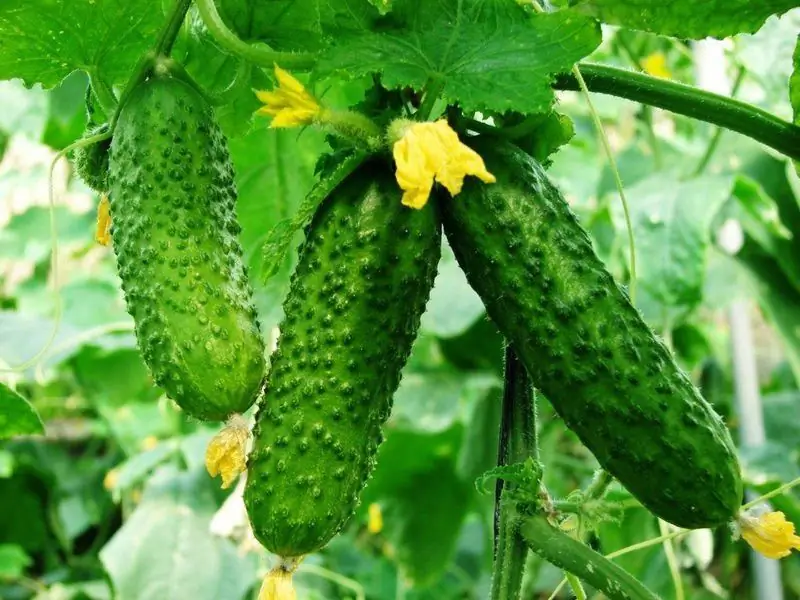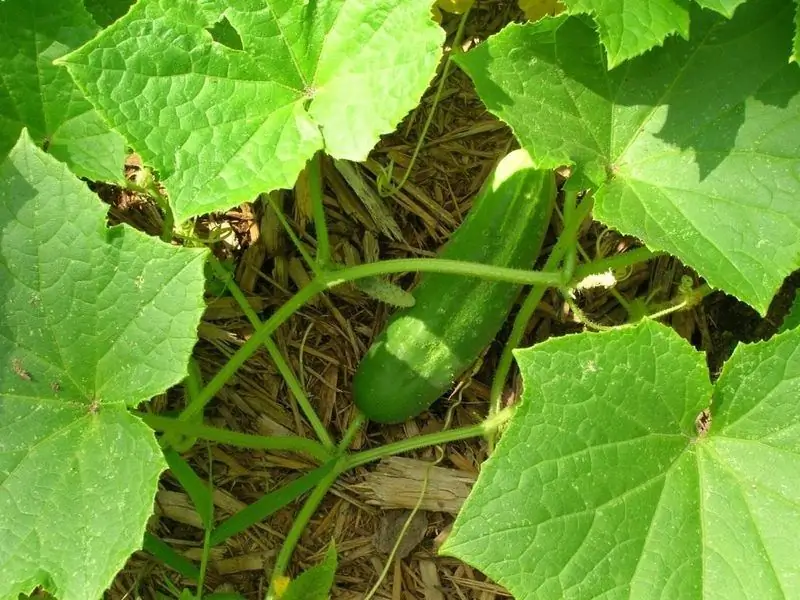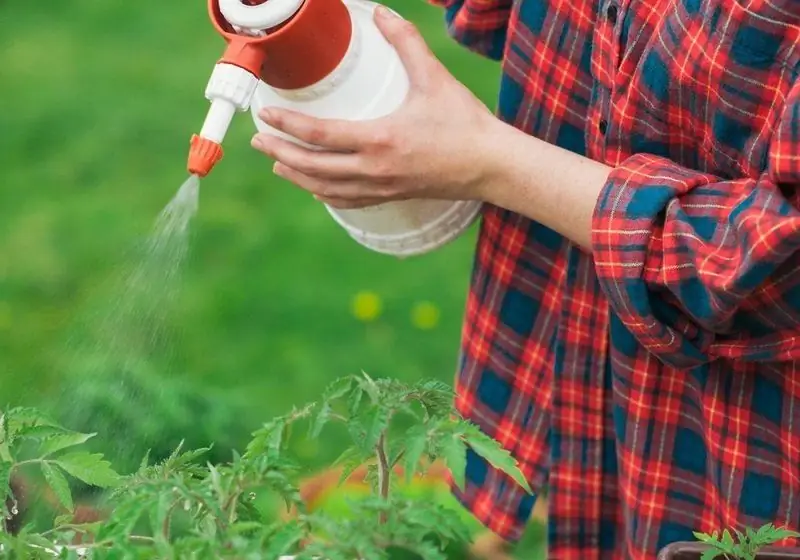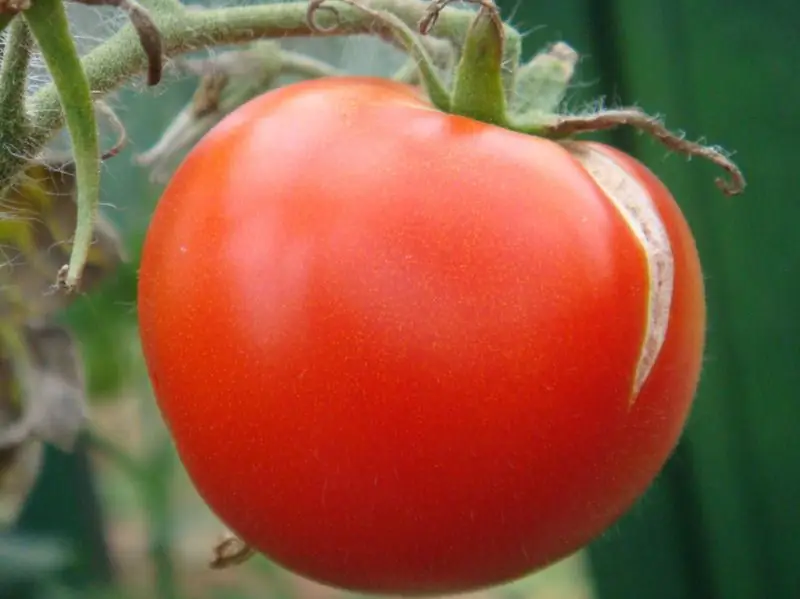
Table of contents:
- Author Bailey Albertson [email protected].
- Public 2023-12-17 12:53.
- Last modified 2025-06-01 07:32.
How to tie cucumbers: clear rules and simple ways

Every year, growers use their favorite cucumber garters or experiment with new methods. Nevertheless, there are those who doubt the benefits of tying. In addition, different gardeners have different conditions for the future harvest (open ground or a greenhouse, the size of the planting site, different from the neighbor in the country, the cultivar, etc.). Let's figure out if a garter is needed at all and what methods are suitable for different conditions.
Content
- 1 Why do you need a garter of cucumbers
-
2 How to tie cucumbers correctly
- 2.1 Preparing the structure in advance
- 2.2 Correct time and place
- 2.3 Correct materials
-
3 Types of tying
- 3.1 Horizontal tying
-
3.2 Vertical tying
3.2.1 Video: 2 ways to tie cucumbers
-
3.3 Tying to the net
3.3.1 Video: how to tie up cucumbers in the open field to the net
- 3.4 Method "Pyramid"
- 3.5 Using the existing support
- 3.6 Cucumber barrel
- 3.7 Cucumber tree
Why do you need a garter of cucumbers
The cucumber was once brought to us from the subtropics, and now it is found everywhere - from garden beds to a greenhouse on the balcony. Having received national recognition, the overseas guest retained his love for sunlight and humidity, without which a good harvest cannot be achieved. Some summer residents believe: cucumbers that are not tied up receive more moisture, and if the ground is open and the summer is sunny, you should not bother with a garter at all. But what is really going on?
Firstly, not tied cucumber lashes form thickets on the ground, in which there is no uniform access of daylight to each leaf (and after all, any leaf can release the fruit from the bosom) - as a result, the yield decreases, and the ovaries are less poured, formed curved.

With a lack of light, cucumbers are deformed
Secondly, under the weight of growing cucumbers, the lashes are injured, dry and break, because of which the plant may die. Thirdly, harvesting becomes more difficult: under large leaves you will not immediately notice a ripe vegetable, some fruits may not be seen, and some of them will turn out to be spoiled and unfit for food from a long contact with the soil. If other plants grow in the garden next door, they can also suffer from overgrown cucumber thickets - the lashes tenaciously cover the “neighbor” and bend to the ground.
Tying is even more important in greenhouse conditions. The problem of lack of illumination is solved, because a tied plant has every leaf in the light. The lashes are easily visible from all sides, which means that you can immediately identify the diseased plant and remove the diseased part in time. By letting the weaving lianas grow not on the ground, but higher, the owner-vegetable grower significantly saves space. Thanks to the supports, the plant does not spend much energy on maintaining its own lashes and fruits, side shoots are easily formed and pollination occurs better - as a result, the yield increases.
How to tie cucumbers correctly
So, the expediency of this procedure is beyond doubt. Indeed, it is better to spend time on a garter once and then enjoy the neat well-groomed beds and a generous harvest as a result all season. How to tie up cucumbers correctly? There are general guidelines.
Preparing the structure in advance
Support pillars along the edges of the beds, as well as intermediate pegs for support, must be dug in in advance, before sowing the seeds, so as not to damage the root system of the plants (later, when tying them, you can carefully deepen them). When tying horizontally, the twine is immediately pulled between the posts. Before digging in the supports, it is advisable to treat wooden stakes against mold, and metal ones against corrosion.
Right time and place
The principle is not too late and not too early. The plant should reach 25-35 cm (usually 4-6 leaves are formed by this time), however, if you go late, the stems will become inflexible and brittle.
Tying is done under the first or second sheet.
The right materials
To tie the stem to the support, not thin laces are suitable, and even less wire or fishing line (they will eventually cut into the stems and damage them), but a wide cord or strips of fabric 3-4 cm wide. It is best made of synthetic fibers, as on moisture stagnates in natural material - decay of the whip may develop. The garter should not be tight: if you squeeze the stems, the bush will feed worse, injuries and even the death of the plant are possible.
Here is such a simple inventory you will need for a vertical or horizontal garter of cucumbers:
- wooden posts (rods) or metal pins;
- strong wide rope;
- synthetic fabric cut into strips.
Some vegetable growers use "grandmother's remedy" - nylon tights, but this is not entirely correct: such elastic garters can slip off the stems under the weight of the fruits being formed. Reusable clips that hold cucumber brushes well have proven themselves.

Tights are a budget garter, but not the most reliable
Types of tying
Popular and simple methods are vertical and horizontal garters, as well as the use of a special mesh. In addition, they use ready-made trellises, arches, practice new unusual ways of forming a plant: a cucumber tree, cucumbers in a barrel, etc.
Horizontal tying
This simple method is especially suitable for beginners. With this method, between the supporting vertical posts, the ropes are stretched horizontally along the plant bed. It turns out several rows - rope tiers, the distance between them is no more than 25-30 cm. If two support posts at the edges are not enough, you can make intermediate vertical supports by attaching them to rope trellises. The stem is carefully tied at the bottom to the rope, then when forming the bush, you do not need to remove the mustache (they will pull the cucumber to the trellises).
The support should initially be high so that significantly grown plants do not hang down. It is sometimes helpful to thin out the bush to leave enough nourishment for the working parts and not feed dense greens without fruit. This method is great for outdoor cultivation and low-rise greenhouses.

The horizontal garter is very easy to make
Vertical tying
With this simple method, columns are installed along the edges of the bed, between them a wide string is stretched horizontally. From above, strips of fabric are attached to it, to which the ends of the stems are carefully tied (each stem to its own rope). The cucumber will grow on a vertical support, wrapping around it.

Vertical garter saves space on the beds
Sometimes in this method, not hanging fabric strips are used, but special rods - supports (do not forget to dig them in in advance). The main stem and about 7-8 lashes above are left to form. Extra mustache must be removed so that the plant's strength is not wasted. During the picking period, it is worth removing the spent leaves (immediately lubricating the wound site with a strong solution of potassium permanganate) - this way the working leaves will get more nutrition.
The vertical garter is used in open ground, in greenhouses and for arranging a vegetable garden on the balcony. Thanks to this method of garters, a large crop can be harvested in a small area.
Video: 2 ways to garter cucumbers
Tying to the net
In this method, not ropes are used, but a net with large cells bought in a special store (the size of the cells is chosen depending on the size of the bushes). Do not use a net that is too finely meshed - this will prevent the leaves and fruits from developing normally. Pegs are installed at opposite ends of the bed, a net is pulled over them. If two supports are not enough, additional support posts can be built. With this method, the plant is practically not tied to the net, it crawls and braids the base itself.
There is an interesting option when the network is mounted independently as a rigid structure - from rods, strips (wooden or metal). This method is more commonly used outdoors, but it is also suitable for greenhouses.
Video: how to tie up cucumbers in the open field to the net
Method "Pyramid"
If there is very little free space on the site, but you want cucumbers, you can resort to the following method. Cucumber bushes are planted in a circle, after digging in several wooden pegs. The supports are connected at the top and tied with twine - it turns out something like a pyramid. Then you need to pull horizontally several rows of rope - the lashes will crawl up these tiers. In one such structure, from 10 to 20 bushes are tied.

This design is a decorative element on the site
Using the existing support
Cucumbers can be planted near fences, verandas, gazebos as vines wrapping around a support. The fence will act as a natural protection for cucumbers from the wind. Apart from purely practical purposes, this growing method creates an attractive setting on the site. You only need to follow the shoots, preventing sloppy growth.

Cucumbers are ideally protected from wind and drafts
Cucumber barrel
Another way to save space on the site and also to decorate it - "a barrel of cucumbers". The capacity must be necessarily high, because cucumber lashes reach 2 meters in length. The grown stems come out of the barrel and hang picturesquely over the edge. This method is suitable not only for aesthetes, but also for the laziest gardeners, because there is no need to assemble a structure from ropes and stakes.

Cucumbers in a barrel - a non-standard solution for the site
When growing cucumbers in this way, it is important to prevent moisture stagnation in the barrel so that the roots do not rot. In this case, the drainage layer will not greatly affect the situation, so old leaky containers are ideal. If there are no holes, then you should drill them yourself. Another option is to place barrels without a bottom on the site.
If metal or plastic containers are used, pay attention to the edges for sharpness. In this case, it will be necessary to protect the stems from injury. To do this, you can use a rubber hose cut in half and slipped over the edge of the barrel.
Another tip is to use a light-colored covering material to wrap the container. This is an optional measure, but in southern regions or when the sun is too hot, it will help protect the soil and plant roots from overheating and drying out.
Marigolds (calendula) planted in a barrel of cucumbers are good protection against pests, in particular, against spider mites. You can plant at the rate of 1 bush of marigolds for 7-8 cucumber roots.
Cucumber tree
The cucumber tree is a fun growing method that will save greenhouse space. To do this, you will need the main stem (fixed on the trellis in the center) and side vines, which are allowed to go through separate garters below the main stem. When female ovaries are formed, the lateral lashes are again brought to the main stem. Another option is not to lower the vines below, but simply to spread them along the additional garters to the sides, forming a "crown". As a result, the cucumber will grow similar to a real tree: with a thick trunk and a head of spreading branches. According to gardeners, up to 30 kg of fruit can be removed from one such tree per season.

The cucumber tree will save space in the greenhouse
The owner of the infield is in a sense an experimenter. Even the perfect ready-made recipe can produce unexpected results, and through trial and error, discoveries will appear. It is exciting and useful to search for new items and share your own developments, and the result is a generous harvest of tasty and healthy fruits.
Recommended:
Growing Cucumbers On A Trellis In The Open Field - Rules + Photos And Videos

Features of growing cucumbers on a trellis in the open field. Construction and installation of trellises, preparation for planting cucumbers, rules for planting in open ground
How To Feed Cucumbers In The Open Field If The Leaves Turn Yellow And In Other Cases

Top dressing with slow growth of cucumbers. How to fertilize if the leaves turn yellow. How to feed in a polycarbonate greenhouse. Feeding with yeast. Instructions. Video
How To Plant And Grow Cucumbers In The Open Field: Plant Seeds, Properly Care For Plants (water, Form, Tie Up)

What varieties and hybrids of cucumbers can be grown in the open field. Features of planting seeds and seedlings. Choice of place and timing. The nuances of care and formation
Spraying Tomatoes From Late Blight In The Greenhouse And Open Field

What is late blight and what does it look like. Preventive spraying of tomatoes with folk remedies. Treatments with biologicals and inorganic fungicides
Why Do Tomatoes Crack And Burst (on A Bush In An Open Field And In A Greenhouse), What To Do

Why do tomatoes crack and burst (on a bush in an open field and in a greenhouse). How to deal with the problem
